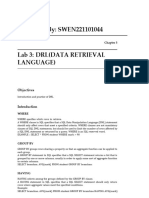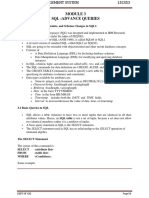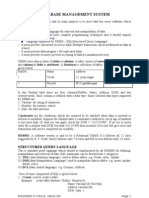SQL Most Important Concepts Part-3
Uploaded by
forotheuse123SQL Most Important Concepts Part-3
Uploaded by
forotheuse123SQL MOST IMPORTANT CONCEPTS-PART 1 HIMANSHU KUMAR
SQL
MOST IMPORTANT CONCEPTS
PLACEMENT PREPARATION
[EXCLUSIVE NOTES]
[SAVE AND SHARE]
Curated By- HIMANSHU KUMAR(LINKEDIN)
TOPICS COVERED-
PART-3 :-
➢ AND and OR operators
➢ Union Clause
➢ Join (Cartesian Join & Self Join)
➢ DROP, DELETE, TRUNCATE
➢ DROP, TRUNCATE
➢ Date functions
➢ EXISTS
➢ WITH clause
➢ NULL Values
HIMANSHU KUMAR(LINKEDIN)
https://www.linkedin.com/in/himanshukumarmahuri
pg. 1 | HIMANSHU KUMAR (LINKEDIN)
AND and OR operators-
In SQL, the AND & OR operators are used for filtering the data
and getting precise results based on conditions. The
SQL AND & OR operators are also used to combine multiple
conditions. These two operators can be combined to test for
multiple conditions in a SELECT, INSERT, UPDATE, or DELETE
statement.
When combining these conditions, it is important to use
parentheses so that the database knows what order to evaluate
each condition.
• The AND and OR operators are used with the WHERE
clause.
• These two operators are called conjunctive operators.
AND Operator:-
This operator displays only those records where both the
conditions condition1 and condition2 evaluates to True.
Syntax:
SELECT * FROM table_name WHERE condition1 AND condi
tion2 and ...conditionN;
table_name: name of the table
condition1,2,..N : first condition, second conditio
n and so on
pg. 2 | HIMANSHU KUMAR (LINKEDIN)
OR Operator:
This operator displays the records where either one of the
conditions condition1 and condition2 evaluates to True. That is,
either condition1 is True or condition2 is True.
Syntax:
SELECT * FROM table_name WHERE condition1 OR condit
ion2 OR... conditionN;
table_name: name of the table
condition1,2,..N : first condition, second conditio
n and so on
Now, we consider a table database to demonstrate AND & OR
operators with multiple cases:
If suppose we want to fetch all the records from the Student
table where Age is 18 and ADDRESS is Delhi. then the query
will be:
Query:
SELECT * FROM Student WHERE Age = 18 AND ADDRESS =
'Delhi';
Output:
pg. 3 | HIMANSHU KUMAR (LINKEDIN)
ROLL_NO NAME ADDRESS PHONE Age
1 Ram Delhi XXXXXXXXXX 18
4 SURESH Delhi XXXXXXXXXX 18
Take another example, to fetch all the records from the Student
table where NAME is Ram and Age is 18.
Query:
SELECT * FROM Student WHERE Age = 18 AND NAME = 'Ra
m';
Output:
ROLL_NO NAME ADDRESS PHONE Age
1 Ram Delhi XXXXXXXXXX 18
To fetch all the records from the Student table where NAME is
Ram or NAME is SUJIT.
Query:
SELECT * FROM Student WHERE NAME = 'Ram' OR NAME =
'SUJIT';
Output:
ROLL_NO NAME ADDRESS PHONE Age
1 Ram Delhi XXXXXXXXXX 18
3 SUJIT ROHTAK XXXXXXXXXX 20
pg. 4 | HIMANSHU KUMAR (LINKEDIN)
ROLL_NO NAME ADDRESS PHONE Age
3 SUJIT ROHTAK XXXXXXXXXX 20
To fetch all the records from the Student table where NAME is
Ram or Age is 20.
Query:
SELECT * FROM Student WHERE NAME = 'Ram' OR Age = 2
0;
Output:
ROLL_NO NAME ADDRESS PHONE Age
1 Ram Delhi XXXXXXXXXX 18
3 SUJIT ROHTAK XXXXXXXXXX 20
3 SUJIT ROHTAK XXXXXXXXXX 20
Combining AND and OR:
We can combine AND and OR operators in the below manner
to write complex queries.
Syntax:
SELECT * FROM table_name WHERE condition1 AND (cond
ition2 OR condition3);
Take an example to fetch all the records from the Student
table where Age is 18 NAME is Ram or RAMESH.
Query:
SELECT * FROM Student WHERE Age = 18 AND (NAME = 'R
am' OR NAME = 'RAMESH');
pg. 5 | HIMANSHU KUMAR (LINKEDIN)
Output:
ROLL_NO NAME ADDRESS PHONE Age
1 Ram Delhi XXXXXXXXXX 18
2 RAMESH GURGAON XXXXXXXXXX 18
Union Clause-
The Union Clause is used to combine two separate select
statements and produce the result set as a union of both the
select statements.
NOTE:
1. The fields to be used in both the select statements must
be in same order, same number and same data type.
2. The Union clause produces distinct values in the result
set, to fetch the duplicate values too UNION ALL must be
used instead of just UNION.
Basic Syntax:-
SELECT column_name(s) FROM table1 UNION SELECT colu
mn_name(s) FROM table2;
Resultant set consists of distinct values.
SELECT column_name(s) FROM table1 UNION ALL SELECT
column_name(s) FROM table2;
Resultant set consists of duplicate values too.
pg. 6 | HIMANSHU KUMAR (LINKEDIN)
Queries:-
• To fetch distinct ROLL_NO from Student and
Student_Details table.
• SELECT ROLL_NO FROM Student UNION SELECT ROLL_N
O FROM Student_Details;
Output:
ROLL_NO
pg. 7 | HIMANSHU KUMAR (LINKEDIN)
ROLL_NO
• To fetch ROLL_NO from Student and Student_Details
table including duplicate values.
• SELECT ROLL_NO FROM Student UNION ALL SELECT RO
LL_NO FROM Student_Details;
Output:
ROLL_NO
• To fetch ROLL_NO , NAME from Student table WHERE
ROLL_NO is greater than 3 and ROLL_NO , Branch from
Student_Details table WHERE ROLL_NO is less than 3 ,
including duplicate values and finally sorting the data by
ROLL_NO.
pg. 8 | HIMANSHU KUMAR (LINKEDIN)
• SELECT ROLL_NO,NAME FROM Student WHERE ROLL_NO>
3
• UNION ALL
• SELECT ROLL_NO,Branch FROM Student_Details WHER
E ROLL_NO<3
• ORDER BY 1;
• Note:The column names in both the select statem
ents can be different but the
• data type must be same.And in the result set t
he name of column used in the first
• select statement will appear.
Output:
ROLL_NO NAME
1 Information Technology
2 Computer Science
4 SURESH
Join (Cartesian Join & Self Join)-
In this article, we will discuss about the remaining two JOINS:
• CARTESIAN JOIN
• SELF JOIN
pg. 9 | HIMANSHU KUMAR (LINKEDIN)
Consider the two tables below:
StudentCourse
CARTESIAN JOIN: The CARTESIAN JOIN is also known as
CROSS JOIN. In a CARTESIAN JOIN there is a join for each row
of one table to every row of another table. This usually
happens when the matching column or WHERE condition is
not specified.
▪ In the absence of a WHERE condition the
CARTESIAN JOIN will behave like a
CARTESIAN PRODUCT . i.e., the number of
rows in the result-set is the product of the
number of rows of the two tables.
▪ In the presence of WHERE condition this JOIN
will function like a INNER JOIN.
pg. 10 | HIMANSHU KUMAR (LINKEDIN)
▪ Generally speaking, Cross join is similar to an
inner join where the join-condition will always
evaluate to True
Syntax:
SELECT table1.column1 , table1.column2, table2.colu
mn1...
FROM table1
CROSS JOIN table2;
table1: First table.
table2: Second table
Example Queries(CARTESIAN JOIN):
• In the below query we will select NAME and Age from
Student table and COURSE_ID from StudentCourse table.
In the output you can see that each row of the table
Student is joined with every row of the table
StudentCourse. The total rows in the result-set = 4 * 4 =
16.
• SELECT Student.NAME, Student.AGE, StudentCourse
.COURSE_ID
• FROM Student
• CROSS JOIN StudentCourse;
pg. 11 | HIMANSHU KUMAR (LINKEDIN)
Output:
2. SELF JOIN: As the name signifies, in SELF JOIN a table is
joined to itself. That is, each row of the table is joined
with itself and all other rows depending on some
conditions. In other words we can say that it is a join
between two copies of the same table.
Syntax:
SELECT a.coulmn1 , b.column2
FROM table_name a, table_name b
WHERE some_condition;
table_name: Name of the table.
some_condition: Condition for selecting the rows.
pg. 12 | HIMANSHU KUMAR (LINKEDIN)
Example Queries(SELF JOIN):
SELECT a.ROLL_NO , b.NAME
FROM Student a, Student b
WHERE a.ROLL_NO < b.ROLL_NO;
Output:
DROP, DELETE, TRUNCATE-
DROP: DROP is used to delete a whole database or just a
table.
TRUNCATE: Truncate statement is also used for same
purpose.
DROP vs TRUNCATE
• Truncate is normally ultra-fast and its ideal for cleaning
out data from a temporary table.
• It also preserves the structure of the table for future use,
unlike drop table where the table is deleted with its full
structure.
pg. 13 | HIMANSHU KUMAR (LINKEDIN)
Basic Syntax for deleting a table:
DROP TABLE table_name;
table_name: Name of the table to be deleted.
Basic Syntax for deleting a whole data base:
DROP DATABASE database_name;
database_name: Name of the database to be deleted.
Basic Syntax for truncating a table:
TRUNCATE TABLE table_name;
table_name: Name of the table to be truncated.
NOTE: Table or Database deletion using DROP statement
cannot be rolled back, so it must be used wisely. Suppose we
have following tables in a database.
DATABASE name - student_data
pg. 14 | HIMANSHU KUMAR (LINKEDIN)
Queries
• To delete Student table from student_data database.
• DELETE TABLE Student;
After running the above query we will be left with only
Student_details table.
• To delete the whole database
• DROP DATABASE student_data;
After running the above query whole database will be
deleted.
• To truncate Student_details table from student_data
database.
• TRUNCATE TABLE Student_details;
After running the above query Student_details table will be
truncated, i.e, the data will be deleted but the structure will
remain in the memory for furter operations.
DROP, TRUNCATE-
DROP
DROP is used to delete a whole database or just a table.The
DROP statement destroys the objects like an existing
database, table, index, or view.
A DROP statement in SQL removes a component from a
relational database management system (RDBMS).
pg. 15 | HIMANSHU KUMAR (LINKEDIN)
Syntax:
DROP object object_name
Examples:
DROP TABLE table_name;
table_name: Name of the table to be deleted.
DROP DATABASE database_name;
database_name: Name of the database to be deleted.
TRUNCATE
TRUNCATE statement is a Data Definition Language (DDL)
operation that is used to mark the extents of a table for
deallocation (empty for reuse). The result of this operation
quickly removes all data from a table, typically bypassing a
number of integrity enforcing mechanisms.
The TRUNCATE TABLE mytable statement is logically (though
not physically) equivalent to the DELETE FROM mytable
statement (without a WHERE clause).
Syntax:
TRUNCATE TABLE table_name;
table_name: Name of the table to be truncated.
DATABASE name - student_data
pg. 16 | HIMANSHU KUMAR (LINKEDIN)
DROP vs TRUNCATE-
• Truncate is normally ultra-fast and its ideal for deleting
data from a temporary table.
• Truncate preserves the structure of the table for future
use, unlike drop table where the table is deleted with its
full structure.
• Table or Database deletion using DROP
statement cannot be rolled back, so it must be used
wisely.
Queries
• To delete the whole database
• DROP DATABASE student_data;
pg. 17 | HIMANSHU KUMAR (LINKEDIN)
After running the above query whole database will be deleted.
• To truncate Student_details table from student_data
database.
• TRUNCATE TABLE Student_details;
After running the above query Student_details table will be
truncated, i.e, the data will be deleted but the structure will
remain in the memory for further operations.
Date functions-
In SQL, dates are complicated for newbies, since while
working with database, the format of the date in table must be
matched with the input date in order to insert. In various
scenarios instead of date, datetime (time is also involved with
date) is used.
In MySql the default date functions are:
• NOW(): Returns the current date and time. Example:
• SELECT NOW();
Output:
2017-01-13 08:03:52
• CURDATE(): Returns the current date. Example:
• SELECT CURDATE();
pg. 18 | HIMANSHU KUMAR (LINKEDIN)
Output:
2017-01-13
• CURTIME(): Returns the current time. Example:
• SELECT CURTIME();
Output:
08:05:15
• DATE(): Extracts the date part of a date or date/time
expression. Example:
For the below table named 'Test'
Id Name BirthTime
4120 Pratik 1996-09-26 16:44:15.581
• SELECT Name, DATE(BirthTime) AS BirthDate FROM
Test;
• Output:
Name BirthDate
Pratik 1996-09-26
• EXTRACT(): Returns a single part of a date/time. Syntax:
• EXTRACT(unit FROM date);
There are several units that can be considered but only some
are used such as:
pg. 19 | HIMANSHU KUMAR (LINKEDIN)
MICROSECOND, SECOND, MINUTE, HOUR, DAY, WEEK,
MONTH, QUARTER, YEAR, etc.
And 'date' is a valid date expression.
Example:
For the below table named 'Test'
Id Name BirthTime
4120 Pratik 1996-09-26 16:44:15.581
Queries
SELECT Name, Extract(DAY FROM BirthTime) AS BirthDa
y FROM Test;
Output:
Name BirthDay
Pratik 26
SELECT Name, Extract(YEAR FROM BirthTime) AS BirthY
ear FROM Test;
Output:
Name BirthYear
Pratik 1996
SELECT Name, Extract(SECOND FROM BirthTime) AS Birt
hSecond FROM Test;
pg. 20 | HIMANSHU KUMAR (LINKEDIN)
Output:
Name BirthSecond
Pratik 581
• DATE_ADD() : Adds a specified time interval to a date
Syntax:
• DATE_ADD(date, INTERVAL expr type);
Where, date - valid date expression and expr is the number
of interval we want to add.
and type can be one of the following:
MICROSECOND, SECOND, MINUTE, HOUR, DAY, WEEK,
MONTH, QUARTER, YEAR, etc.
Example:
For the below table named 'Test'
Id Name BirthTime
4120 Pratik 1996-09-26 16:44:15.581
Queries
o SELECT Name, DATE_ADD(BirthTime, INTERVAL 1
YEAR) AS BirthTimeModified FROM Test;
pg. 21 | HIMANSHU KUMAR (LINKEDIN)
Output:
Name BirthTimeModified
Pratik 1997-09-26 16:44:15.581
o SELECT Name, DATE_ADD(BirthTime, INTERVAL 3
0 DAY) AS BirthDayModified FROM Test;
Output:
Name BirthDayModified
Pratik 1996-10-26 16:44:15.581
o SELECT Name, DATE_ADD(BirthTime, INTERVAL 4
HOUR) AS BirthHourModified FROM Test;
Output:
Name BirthSecond
Pratik 1996-10-26 20:44:15.581
• DATE_SUB(): Subtracts a specified time interval from a
date. Syntax for DATE_SUB is same as DATE_ADD just
the difference is that DATE_SUB is used to subtract a
given interval of date.
• DATEDIFF(): Returns the number of days between two
dates.Syntax:
• DATEDIFF(date1, date2);
• date1 & date2- date/time expression
pg. 22 | HIMANSHU KUMAR (LINKEDIN)
Example:
SELECT DATEDIFF('2017-01-13','2017-01-03') AS DateD
iff;
Output:
DateDiff
10
• DATE_FORMAT(): Displays date/time data in different
formats.Syntax:
• DATE_FORMAT(date,format);
date is a valid date and format specifies the output format for
the date/time. The formats that can be used are:
o %a-Abbreviated weekday name (Sun-Sat)
o %b-Abbreviated month name (Jan-Dec)
o %c-Month, numeric (0-12)
o %D-Day of month with English suffix (0th, 1st, 2nd, 3rd)
o %d-Day of month, numeric (00-31)
o %e-Day of month, numeric (0-31)
o %f-Microseconds (000000-999999)
o %H-Hour (00-23)
o %h-Hour (01-12)
o %I-Hour (01-12)
o %i-Minutes, numeric (00-59)
o %j-Day of year (001-366)
o %k-Hour (0-23)
o %l-Hour (1-12)
o %M-Month name (January-December)
o %m-Month, numeric (00-12)
pg. 23 | HIMANSHU KUMAR (LINKEDIN)
o %p-AM or PM
o %r-Time, 12-hour (hh:mm:ss followed by AM or PM)
o %S-Seconds (00-59)
o %s-Seconds (00-59)
o %T-Time, 24-hour (hh:mm:ss)
o %U-Week (00-53) where Sunday is the first day of week
o %u-Week (00-53) where Monday is the first day of week
o %V-Week (01-53) where Sunday is the first day of week,
used with %X
o %v-Week (01-53) where Monday is the first day of week,
used with %x
o %W-Weekday name (Sunday-Saturday)
o %w-Day of the week (0=Sunday, 6=Saturday)
o %X-Year for the week where Sunday is the first day of
week, four digits, used with %V
o %x-Year for the week where Monday is the first day of
week, four digits, used with %v
o %Y-Year, numeric, four digits
o %y-Year, numeric, two digits
Example:
DATE_FORMAT(NOW(),'%d %b %y')
Result:
13 Jan 17
pg. 24 | HIMANSHU KUMAR (LINKEDIN)
EXISTS-
The EXISTS condition in SQL is used to check whether the
result of a correlated nested query is empty (contains no
tuples) or not. The result of EXISTS is a boolean value True or
False. It can be used in a SELECT, UPDATE, INSERT or
DELETE statement.
Syntax:
SELECT column_name(s)
FROM table_name
WHERE EXISTS
(SELECT column_name(s)
FROM table_name
WHERE condition);
Examples:
Consider the following two relation "Customers" and "Orders".
pg. 25 | HIMANSHU KUMAR (LINKEDIN)
Queries
1. Using EXISTS condition with SELECT statement To
fetch the first and last name of the customers who placed
atleast one order.
SELECT fname, lname
FROM Customers
WHERE EXISTS (SELECT * FROM Orders WHERE Customer
s.customer_id = Orders.c_id);
Output:
2. Using NOT with EXISTS Fetch last and first name of the
customers who has not placed any order.
SELECT lname, fname
FROM Customer
WHERE NOT EXISTS (SELECT *FROM Orders WHERE Custo
mers.customer_id = Orders.c_id);
pg. 26 | HIMANSHU KUMAR (LINKEDIN)
Output:
3. Using EXISTS condition with DELETE statement Delete
the record of all the customer from Order Table whose
last name is 'Mehra'.
DELETE
FROM Orders
WHERE EXISTS (SELECT *FROM customers WHERE Custom
ers.customer_id = Orders.cid AND Customers.lname
= 'Mehra'); SELECT * FROM Orders;
Output:
4. Using EXISTS condition with UPDATE
statement Update the lname as 'Kumari' of customer in
Customer Table whose customer_id is 401.
UPDATE Customers
SET lname = 'Kumari'
WHERE EXISTS (SELECT *FROM Customers WHERE custom
er_id = 401);
SELECT * FROM Customers;
pg. 27 | HIMANSHU KUMAR (LINKEDIN)
Output:
WITH clause-
The SQL WITH clause was introduced by Oracle in the Oracle
9i release 2 database. The SQL WITH clause allows you to
give a sub-query block a name (a process also called sub-
query refactoring), which can be referenced in several places
within the main SQL query.
• The clause is used for defining a temporary relation such
that the output of this temporary relation is available and
is used by the query that is associated with the WITH
clause.
• Queries that have an associated WITH clause can also be
written using nested sub-queries but doing so add more
complexity to read/debug the SQL query.
• WITH clause is not supported by all database system.
• The name assigned to the sub-query is treated as though
it was an inline view or table
pg. 28 | HIMANSHU KUMAR (LINKEDIN)
• The SQL WITH clause was introduced by Oracle in the
Oracle 9i release 2 database.
Syntax:
WITH temporaryTable (averageValue) as(SELECT avg(At
tr1)FROM Table) SELECT Attr1 FROM Table, temporaryT
able WHERE Table.Attr1 > temporaryTable.averageValu
e;
In this query, WITH clause is used to define a temporary
relation temporaryTable that has only 1 attribute
averageValue. averageValue holds the average value of
column Attr1 described in relation Table. The SELECT
statement that follows the WITH clause will produce only
those tuples where the value of Attr1 in relation Table is
greater than the average value obtained from the WITH clause
statement.
Note: When a query with a WITH clause is executed, first the
query mentioned within the clause is evaluated and the
output of this evaluation is stored in a temporary relation.
Following this, the main query associated with the
WITH clause is finally executed that would use the temporary
relation produced.
pg. 29 | HIMANSHU KUMAR (LINKEDIN)
Queries
Example 1: Find all the employee whose salary is more than
the average salary of all employees.
Name of the relation: Employee
EmployeeID Name Salary
100011 Smith 50000
100022 Bill 94000
100027 Sam 70550
100845 Walden 80000
115585 Erik 60000
1100070 Kate 69000
SQL Query:
WITH temporaryTable(averageValue) as
(SELECT avg(Salary)
from Employee)
SELECT EmployeeID,Name, Salary
FROM Employee, temporaryTable
WHERE Employee.Salary > temporaryTable.aver
ageValue;
pg. 30 | HIMANSHU KUMAR (LINKEDIN)
Output:
EmployeeID Name Salary
100022 Bill 94000
100845 Walden 80000
Explanation: The average salary of all employees is 70591.
Therefore, all employees whose salary is more than the
obtained average lies in the output relation.
Example 2: Find all the airlines where the total salary of all
pilots in that airline is more than the average of total salary of
all pilots in the database.
Name of the relation: Pilot
EmployeeID Airline Name Salary
70007 Airbus 380 Kim 60000
70002 Boeing Laura 20000
10027 Airbus 380 Will 80050
10778 Airbus 380 Warren 80780
115585 Boeing Smith 25000
114070 Airbus 380 Katy 78000
pg. 31 | HIMANSHU KUMAR (LINKEDIN)
SQL Query:
WITH totalSalary(Airline, total) as
(SELECT Airline, sum(Salary)
FROM Pilot
GROUP BY Airline),
airlineAverage(avgSalary) as
(SELECT avg(Salary)
FROM Pilot )
SELECT Airline
FROM totalSalary, airlineAverage
WHERE totalSalary.total > airlineAverage.avgSal
ary;
Output:
Airline
Airbus 380
Explanation: The total salary of all pilots of Airbus 380 =
298,830 and that of Boeing = 45000. Average salary of all
pilots in the table Pilot = 57305. Since only the total salary of
all pilots of Airbus 380 is greater than the average salary
obtained, so Airbus 380 lies in the output relation.
pg. 32 | HIMANSHU KUMAR (LINKEDIN)
Important Points:
• The SQL WITH clause is good when used with complex
SQL statements rather than simple ones
• It also allows you to break down complex SQL queries
into smaller ones which make it easy for debugging and
processing the complex queries.
• The SQL WITH clause is basically a drop-in replacement
to the normal sub-query.
NULL Values-
In SQL there may be some records in a table that do not have
values or data for every field. This could be possible because at
a time of data entry information is not available. So SQL
supports a special value known as NULL which is used to
represent the values of attributes that may be unknown or not
apply to a tuple. SQL places a NULL value in the field in the
absence of a user-defined value. For example, the
Apartment_number attribute of an address applies only to
address that are in apartment buildings and not to other types
of residences.
Importance of NULL value:
• It is important to understand that a NULL value is different
from a zero value.
• A NULL value is used to represent a missing value, but that
it usually has one of three different interpretations:
o The value unknown (value exists but is not known)
o Value not available (exists but is purposely withheld)
pg. 33 | HIMANSHU KUMAR (LINKEDIN)
o Attribute not applicable (undefined for this tuple)
• It is often not possible to determine which of the meanings
is intended. Hence, SQL does not distinguish between the
different meanings of NULL.
Principles of NULL values:
• Setting a NULL value is appropriate when the actual value
is unknown, or when a value would not be meaningful.
• A NULL value is not equivalent to a value of ZERO if the
data type is a number and is not equivalent to spaces if the
data type is character.
• A NULL value can be inserted into columns of any data
type.
• A NULL value will evaluate NULL in any expression.
• Suppose if any column has a NULL value, then UNIQUE,
FOREIGN key, CHECK constraints will ignore by SQL.
In general, each NULL value is considered to be different from
every other NULL in the database. When a NULL is involved in
a comparison operation, the result is considered to be
UNKNOWN. Hence, SQL uses a three-valued logic with
values True, False, and Unknown. It is, therefore, necessary to
define the results of three-valued logical expressions when the
logical connectives AND, OR, and NOT are used.
pg. 34 | HIMANSHU KUMAR (LINKEDIN)
How to test for NULL Values?
SQL allows queries that check whether an attribute value is
NULL. Rather than using = or to compare an attribute value to
NULL, SQL uses IS and IS NOT. This is because SQL considers
each NULL value as being distinct from every other NULL value,
so equality comparison is not appropriate. Now, consider the
following Employee Table,
pg. 35 | HIMANSHU KUMAR (LINKEDIN)
Suppose if we find the Fname, Lname of the Employee having
no Super_ssn then the query will be:
Query
SELECT Fname, Lname FROM Employee WHERE Super_ssn I
S NULL;
Output:
Now if we find the Count of the number of Employees having
Super_ssn.
Query:
SELECT COUNT(*) AS Count FROM Employee WHERE Super_
ssn IS NOT NULL;
Output:
HIMANSHU KUMAR(LINKEDIN)
https://www.linkedin.com/in/himanshukumarmahuri
CREDITS- INTERNET
DISCLOSURE- THE DATA AND IMAGES ARE TAKEN FROM GOOGLE AND INTERNET.
𝑪𝑯𝑬𝑪𝑲𝑶𝑼𝑻 𝑨𝑵𝑫 𝑫𝑶𝑾𝑵𝑳𝑶𝑨𝑫 𝑴𝒀 𝑨𝑳𝑳 𝑵𝑶𝑻𝑬𝑺
𝑳𝑰𝑵𝑲- https://linktr.ee/exclusive_notes
pg. 36 | HIMANSHU KUMAR (LINKEDIN)
You might also like
- Sql-Most Important Concepts Placement Preparation: (Save and Share)No ratings yetSql-Most Important Concepts Placement Preparation: (Save and Share)46 pages
- Introduction To SQL: P212 Information Management100% (1)Introduction To SQL: P212 Information Management30 pages
- SQL: Just The Basics: Thursday, February 05, 2009No ratings yetSQL: Just The Basics: Thursday, February 05, 200910 pages
- Sql:Advance Queries: Structured Query Language (SQL) Was Designed and Implemented at IBM ResearchNo ratings yetSql:Advance Queries: Structured Query Language (SQL) Was Designed and Implemented at IBM Research21 pages
- Hedge Fund Secrets An Introduction To Quantitative Portfolio Management Philip J. Romero & Tucker Balch Download PDF100% (2)Hedge Fund Secrets An Introduction To Quantitative Portfolio Management Philip J. Romero & Tucker Balch Download PDF34 pages
- Complexometric Titration: DR Mohammad Kaisarul Islam Department of Pharmaceutical Chemistry, DUNo ratings yetComplexometric Titration: DR Mohammad Kaisarul Islam Department of Pharmaceutical Chemistry, DU20 pages
- Differences and Similarities Between L1 & L2 Acquisition100% (1)Differences and Similarities Between L1 & L2 Acquisition33 pages
- Lecture 7 - Universal Design EvaluationsNo ratings yetLecture 7 - Universal Design Evaluations30 pages
- Community Health, 1-3. Area of Concern & Relevance To Occupational Therapy PracticeNo ratings yetCommunity Health, 1-3. Area of Concern & Relevance To Occupational Therapy Practice3 pages
- CLIMBS - Motor Car - Claim Application FormNo ratings yetCLIMBS - Motor Car - Claim Application Form1 page
- 2018-2017 لوا سروك -2-ةمزلم Volumetric analysis (titration analysis) :- عوضوم 30 ةحفص عباتNo ratings yet2018-2017 لوا سروك -2-ةمزلم Volumetric analysis (titration analysis) :- عوضوم 30 ةحفص عبات26 pages
- TEXTO How Fake Images Change Our Memory and BehaviorNo ratings yetTEXTO How Fake Images Change Our Memory and Behavior3 pages
- Ch17 - Additional Aspects of Aqueous EquilibriaNo ratings yetCh17 - Additional Aspects of Aqueous Equilibria12 pages
- Mr. Sachin Jaysawal So Om Prakash Imampur Chanaipur Ambedkar Nagar, Up - 224168 Uttar Pradesh, IndiaNo ratings yetMr. Sachin Jaysawal So Om Prakash Imampur Chanaipur Ambedkar Nagar, Up - 224168 Uttar Pradesh, India8 pages
- COC For HO &GP by Health Info and Vacancy News ChannelNo ratings yetCOC For HO &GP by Health Info and Vacancy News Channel114 pages
- Job Analysis Is The Systematic Process of Collecting and Making Judgments About All The Important Information Related To A JobNo ratings yetJob Analysis Is The Systematic Process of Collecting and Making Judgments About All The Important Information Related To A Job8 pages
- Presentation On Leadership Skills and Change ManagementNo ratings yetPresentation On Leadership Skills and Change Management23 pages
- Evidence and Evolution The Logic Behind The Science PDFNo ratings yetEvidence and Evolution The Logic Behind The Science PDF2 pages
- Sql-Most Important Concepts Placement Preparation: (Save and Share)Sql-Most Important Concepts Placement Preparation: (Save and Share)
- Sql:Advance Queries: Structured Query Language (SQL) Was Designed and Implemented at IBM ResearchSql:Advance Queries: Structured Query Language (SQL) Was Designed and Implemented at IBM Research
- Hedge Fund Secrets An Introduction To Quantitative Portfolio Management Philip J. Romero & Tucker Balch Download PDFHedge Fund Secrets An Introduction To Quantitative Portfolio Management Philip J. Romero & Tucker Balch Download PDF
- Complexometric Titration: DR Mohammad Kaisarul Islam Department of Pharmaceutical Chemistry, DUComplexometric Titration: DR Mohammad Kaisarul Islam Department of Pharmaceutical Chemistry, DU
- Differences and Similarities Between L1 & L2 AcquisitionDifferences and Similarities Between L1 & L2 Acquisition
- Community Health, 1-3. Area of Concern & Relevance To Occupational Therapy PracticeCommunity Health, 1-3. Area of Concern & Relevance To Occupational Therapy Practice
- 2018-2017 لوا سروك -2-ةمزلم Volumetric analysis (titration analysis) :- عوضوم 30 ةحفص عبات2018-2017 لوا سروك -2-ةمزلم Volumetric analysis (titration analysis) :- عوضوم 30 ةحفص عبات
- TEXTO How Fake Images Change Our Memory and BehaviorTEXTO How Fake Images Change Our Memory and Behavior
- Mr. Sachin Jaysawal So Om Prakash Imampur Chanaipur Ambedkar Nagar, Up - 224168 Uttar Pradesh, IndiaMr. Sachin Jaysawal So Om Prakash Imampur Chanaipur Ambedkar Nagar, Up - 224168 Uttar Pradesh, India
- COC For HO &GP by Health Info and Vacancy News ChannelCOC For HO &GP by Health Info and Vacancy News Channel
- Job Analysis Is The Systematic Process of Collecting and Making Judgments About All The Important Information Related To A JobJob Analysis Is The Systematic Process of Collecting and Making Judgments About All The Important Information Related To A Job
- Presentation On Leadership Skills and Change ManagementPresentation On Leadership Skills and Change Management
- Evidence and Evolution The Logic Behind The Science PDFEvidence and Evolution The Logic Behind The Science PDF





























































































